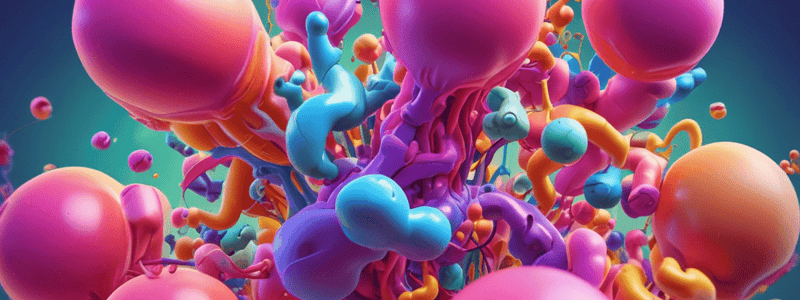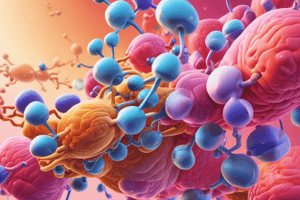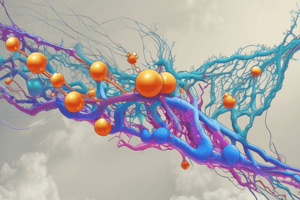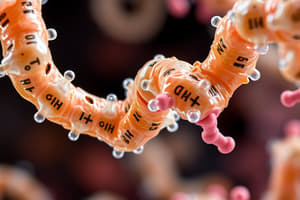Podcast
Questions and Answers
What type of enzyme is being discussed in the text?
What type of enzyme is being discussed in the text?
- Protease
- Acetylcholinesterase (correct)
- Lipase
- Amylase
What is the purpose of the medications that target this enzyme?
What is the purpose of the medications that target this enzyme?
- To transport the enzyme to different parts of the body
- To decrease the activity of the enzyme (correct)
- To modify the structure of the enzyme
- To increase the activity of the enzyme
Which of the following is NOT a type of acetylcholinesterase inhibitor?
Which of the following is NOT a type of acetylcholinesterase inhibitor?
- Ibuprofen (correct)
- Donepezil
- Rivastigmine
- Galantamine
In which condition are acetylcholinesterase inhibitors commonly used?
In which condition are acetylcholinesterase inhibitors commonly used?
What happens when a patient takes the drug for the first time?
What happens when a patient takes the drug for the first time?
What is the primary mechanism of action of acetylcholinesterase inhibitors?
What is the primary mechanism of action of acetylcholinesterase inhibitors?
How many times must a patient take the drug to experience the full effect?
How many times must a patient take the drug to experience the full effect?
What is the key information provided in the given text?
What is the key information provided in the given text?
Which of the following is true about the drug's effect on the patient?
Which of the following is true about the drug's effect on the patient?
What is the most important information provided in the given text?
What is the most important information provided in the given text?
What does the shift to the right indicate in terms of agonist concentration?
What does the shift to the right indicate in terms of agonist concentration?
How does the plateau Vmax relate to the shift to the right?
How does the plateau Vmax relate to the shift to the right?
What effect does an increase in agonist concentration have on reaching Vmax after a right shift?
What effect does an increase in agonist concentration have on reaching Vmax after a right shift?
How does a left shift in this context differ from a right shift in terms of agonist concentration?
How does a left shift in this context differ from a right shift in terms of agonist concentration?
If an agonist requires less concentration to reach Vmax, what might be the effect on the effectiveness of the agonist?
If an agonist requires less concentration to reach Vmax, what might be the effect on the effectiveness of the agonist?
What is the relationship between Kd and potency?
What is the relationship between Kd and potency?
What can be concluded about the potency of two drugs based on their required doses?
What can be concluded about the potency of two drugs based on their required doses?
Which two over-the-counter medications are mentioned in the text?
Which two over-the-counter medications are mentioned in the text?
What is the relationship between Kd and drug potency?
What is the relationship between Kd and drug potency?
What is the main conclusion drawn in the text?
What is the main conclusion drawn in the text?
What does EC50 (KM) represent?
What does EC50 (KM) represent?
What is Emax in pharmacology terms?
What is Emax in pharmacology terms?
If a drug has an EC50 value of 75, what does this indicate?
If a drug has an EC50 value of 75, what does this indicate?
Which term describes the dose of the antagonist that blocks 50% of the full effect?
Which term describes the dose of the antagonist that blocks 50% of the full effect?
What happens when a drug reaches its Emax value?
What happens when a drug reaches its Emax value?
Flashcards are hidden until you start studying
Study Notes
Enzyme Inhibition
- Acetylcholinesterase is a target for many medications, specifically acetylcholinesterase inhibitors.
Dose-Response Curve
- A shift to the right in the dose-response curve means a higher concentration of agonist is required to reach the maximum response (Vmax).
- EC50 (KM) is the dose of the agonist that produces 50% of the full effect (Emax).
- Emax is the maximal efficacy of the agonist.
Potency and Affinity
- If the dissociation constant (Kd) is low, the potency of the drug is high.
- The potency of a drug is determined by the dose required to produce a specific effect.
Comparing Drug Potency
- If the dose needed for drug X is smaller than the dose needed for drug Y, then drug X is more potent than drug Y.
- Example: ibuprofen and diclofenac sodium (Voltaren) are two over-the-counter medications with different potencies.
Initial Drug Response
- When a patient takes a drug for the first time, they will typically experience the full effect of the drug.
Studying That Suits You
Use AI to generate personalized quizzes and flashcards to suit your learning preferences.






